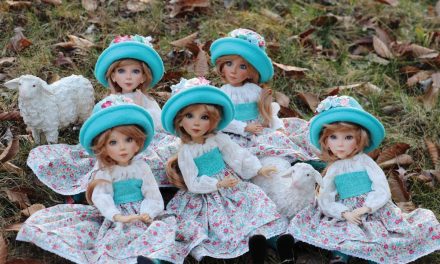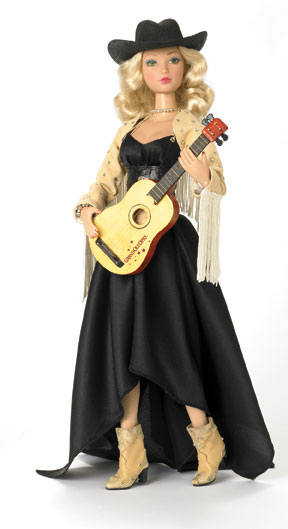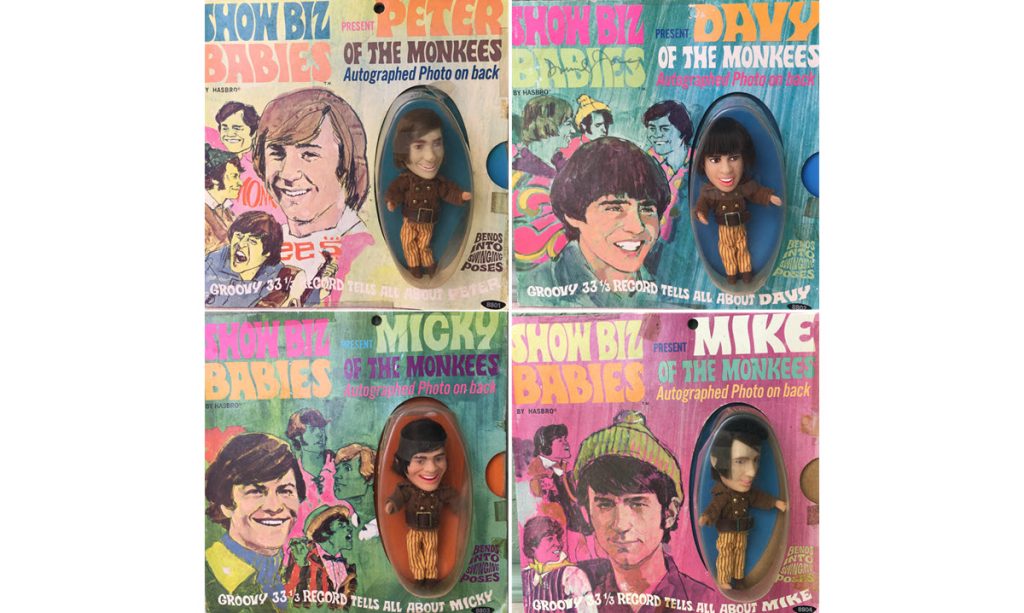
Pop culture reflected in dolls of the ’60s and ’70s
By A. Glenn Mandeville
Dolls courtesy of Sherry and Ron Springsteen
Technical assistance by Richard Chapman
No one can deny the 1960s was a time of turmoil and conflict, but it also was an era of exciting trends in pop music, fashion, and culture. The doll world was certainly no exception and still produced not only the glamour dolls like those of earlier eras but also dolls depicting pop stars and cultural icons that are highly collectible today.
The Monkees
Hasbro Toy Company, never a company to avoid change, made 4-inch all-vinyl dolls of the popular band formed for the television show “The Monkees.” The four musician/actors were: Davy Jones, Mike Nesmith, Peter Tork, and Mickey Dolenz. Dolenz had previously appeared on an early children’s show called “Circus Boy.” Nesmith’s mother, Bette Nesmith Graham, invented Liquid Paper correction fluid, still a popular office staple of today. Jones had previously played the Artful Dodger in the Broadway show “Oliver!” Only Tork and Nesmith had experience working solely as musicians before the show.
The show, the band, and the dolls became a huge hit. The dolls, issued in 1967, were posable, with rooted hair and painted eyes. Each came with a 33 1/3 record that told the individual band member’s story. Our collector friends had Davy Jones personally autograph their doll at a concert. The dolls are very hard to find today, and a complete mint set can sell for up to $1,000. While other Monkees items such as finger puppets and hand puppets were manufactured, none are as elusive as the doll set shown above — they were not as widely available in stores as the other products.
The Beatles
Who can forget The Beatles? Overnight they changed music and fashion forever. The Fab Four consisted of Paul McCartney, Ringo Starr, George Harrison, and John Lennon. From their first appearance on “The Ed Sullivan Show” in the mid-1960s, American children no longer wanted to look like Dad (like in the 1960s sitcoms of the day) but sported Beatles bangs hairdos and bell bottom pants.
The dolls shown below were made by Remco and are 5 inches tall with a solid vinyl body and rooted hair. What makes these dolls valuable, aside from overall condition, is that each came with a plastic guitar or, in Ringo’s case, a drum. Each instrument bore the gold signature of that particular Beatle. The dolls were mass produced and distributed virtually everyplace, including five-and-dime stores such as F.W. Woolworth.
Many people assume that the dolls are valuable but fail to realize that the value depends on their condition. Mint dolls in the package can be seen trading at $200 and up. Just to add to the fun, not shown here are similar dolls released of some characters from the popular 1960s TV shows “The Munsters” and “The Addams Family” — another sign of how much changed during the 1960s.

Barbie & Friends
Even Mattel’s Barbie and her friend P.J. got into the act, with Mod fashions and records. Viewing the early Barbie doll commercials from the early 1960s, one can see that tremendous change happened in a short time. Gone were the little white gloves and full-skirted dresses. The styles shifted to a more casual look called a “cosmetic rebellion,” where Barbie and her growing list of friends sported almost “hippie” clothing and formed a pop/rock group.
The P.J. doll shown below is very rare; it was a Sears gift set shown in the 1971 Sears catalog. It came with the doll dressed in a variation of Barbie’s outfit plus her original fashion and another dressy fashion along with the record that had a catchy pop tune. I had never seen this set before, and it would most likely sell for $250 and up if mint and complete.
Mattel was one of the leaders in change, making sure that Barbie’s image was always changing with the times! Those that followed Barbie from 1959 through the 1960s saw her actually chronicle the ever-changing popular culture and music styles. And that trend continues today!
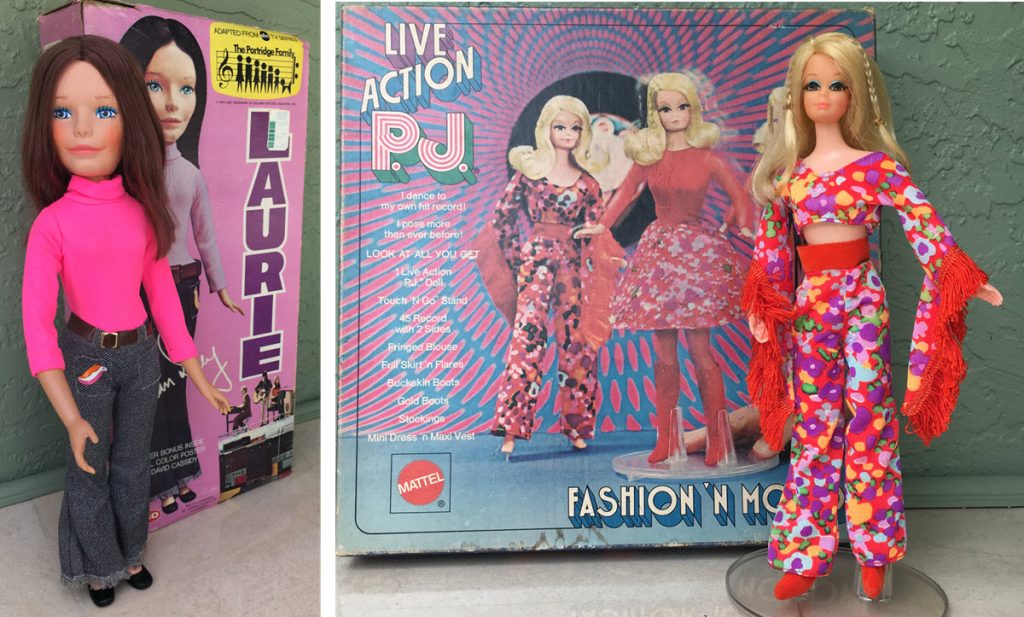
The Partridge Family
Who could forget “The Partridge Family,” with David Cassidy and real-life stepmom Shirley Jones belting out pop tunes. Among the family was chord organ-playing Laurie Partridge, played by Susan Dey. While not a musician, Dey and her head-tossing hair added an air of brother-sister conflict to the show. The show aired from 1970 to 1974. The vinyl Laurie doll shown above had rooted hair and stood 19 inches tall. She was dressed in jeans and a bright pink turtleneck top. The box came with a poster of David Cassidy. One at auction recently sold for $175, but it was perfect in the box with poster.
Signs of the Times
Of course a pop concert needs an audience, and this Remco doll named Herby Hippy was the perfect show attendee! He is 15 inches tall with rooted hair and is all vinyl. One eye winks when you push his stomach! He was made in 1968 and was hard to find then — he’s almost impossible to find today! The right collector might pay $150 or more for a Herby Hippy doll.
These are just a few of the collectible pop star dolls that can be located today with a little work. Less expensive dolls in this genre can be found as well.
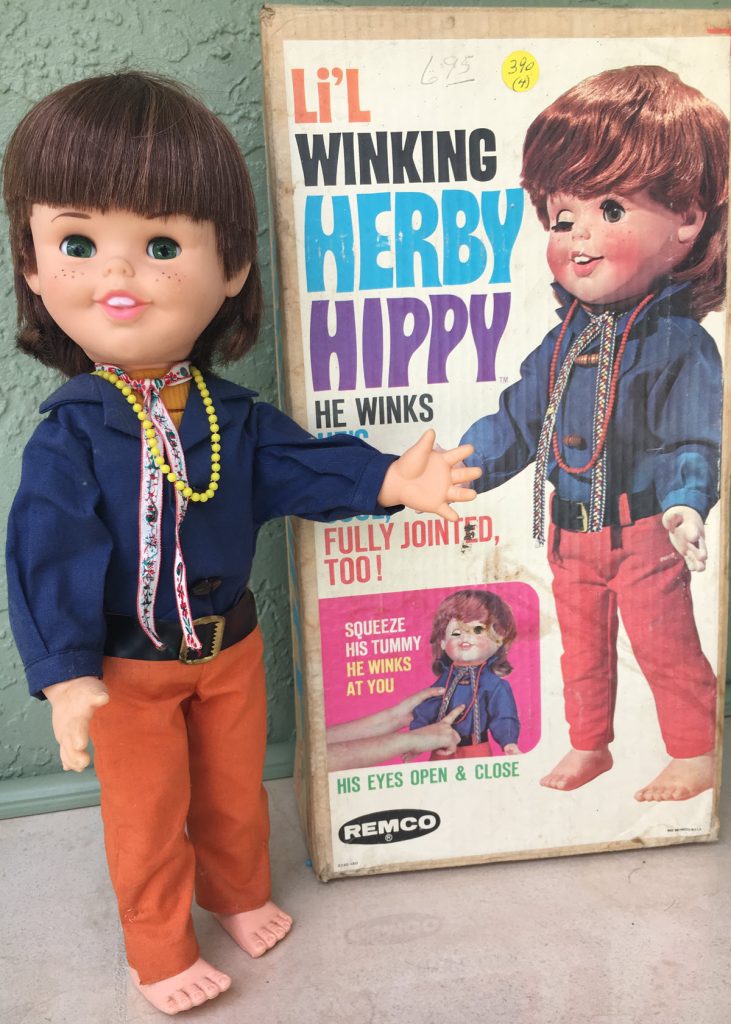
A. Glenn Mandeville is the author of numerous books on dolls and doll collecting and writes his Curious Collector column for each issue of DOLLS magazine.


